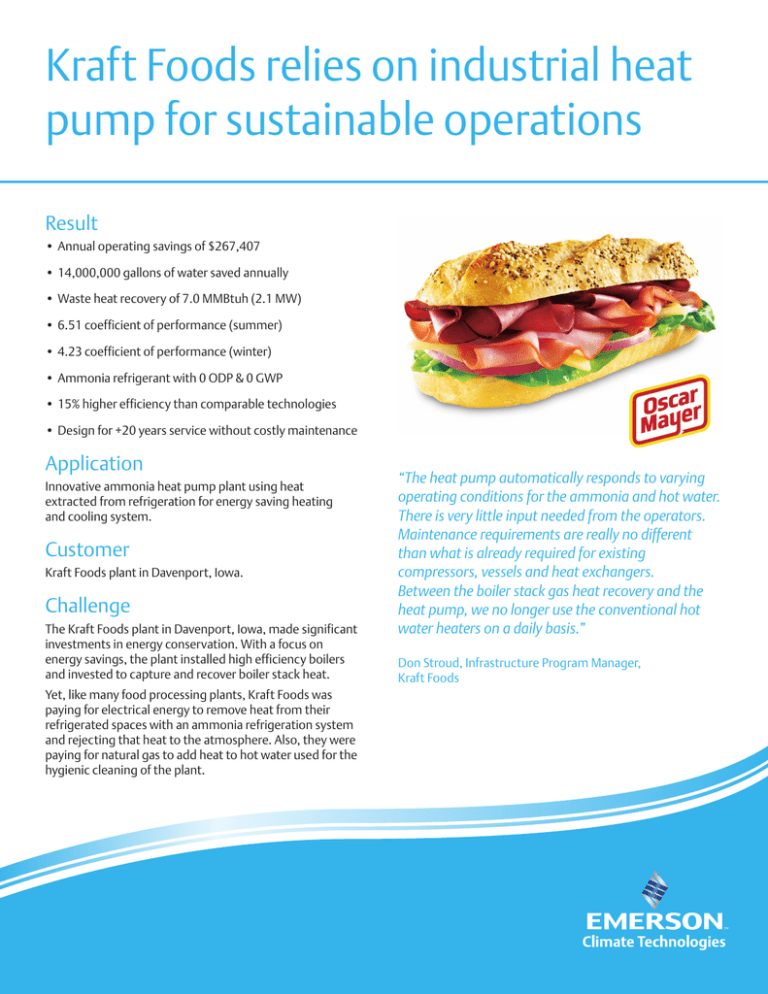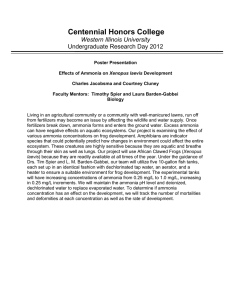
Kraft Foods relies on industrial heat
pump for sustainable operations
Result
•Annual operating savings of $267,407
•14,000,000 gallons of water saved annually
•Waste heat recovery of 7.0 MMBtuh (2.1 MW)
•6.51 coefficient of performance (summer)
•4.23 coefficient of performance (winter)
•Ammonia refrigerant with 0 ODP & 0 GWP
•15% higher efficiency than comparable technologies
•Design for +20 years service without costly maintenance
Application
Innovative ammonia heat pump plant using heat
extracted from refrigeration for energy saving heating
and cooling system.
Customer
Kraft Foods plant in Davenport, Iowa.
Challenge
The Kraft Foods plant in Davenport, Iowa, made significant
investments in energy conservation. With a focus on
energy savings, the plant installed high efficiency boilers
and invested to capture and recover boiler stack heat.
Yet, like many food processing plants, Kraft Foods was
paying for electrical energy to remove heat from their
refrigerated spaces with an ammonia refrigeration system
and rejecting that heat to the atmosphere. Also, they were
paying for natural gas to add heat to hot water used for the
hygienic cleaning of the plant.
“The heat pump automatically responds to varying
operating conditions for the ammonia and hot water.
There is very little input needed from the operators.
Maintenance requirements are really no different
than what is already required for existing
compressors, vessels and heat exchangers.
Between the boiler stack gas heat recovery and the
heat pump, we no longer use the conventional hot
water heaters on a daily basis.”
Don Stroud, Infrastructure Program Manager,
Kraft Foods
If the rejected heat could be captured and used to provide
water heating, substantial energy would be saved. The
highest pressures and temperatures in the refrigeration
system (compressor discharge gas) provided the best
source for heat to be transferred to the sanitation clean-up
water. But, as ammonia refrigeration practitioners who have
employed “heat reclaim” practices have noted, ammonia
at typical condensing pressures, while possessing large
quantities of heat energy, condenses at fairly low
temperatures [75-95°F (24-35°C)]. The transfer of this
energy to city water, through conventional heat exchangers,
to create 145-185°F (63-85°C) wash down water, is only
effective for limited pre-heating of the cold water supply.
If the refrigeration system compressor discharge gas, at
fairly high pressures [180 psig (13.2 atm)] could be fed
directly into the suction of a “heat pump” compressor and
compressed to even higher pressures [i.e. 450-800 psig
(32-55 atm)], condensing this higher pressure ammonia with
cold water in a heat exchanger would capture much larger
quantities of heat energy than heat reclaim and elevate the
cold water supply from 60°F (15°C) up to the 145°F (63°C)
required for wash down.
The requirement of the plant to have the wash down water
classified as a potable supply presented another challenge,
as local codes prohibit potable water to be in direct heat
exchange with ammonia. Using such an ammonia heat
pump system would require a secondary loop, thereby
lowering the efficiency of heat transfer.
Given the need for sustainable projects to clear the same
internal rate of return hurdle as non-sustainable projects, the
challenge was to define and justify the project. The project
costs would include tapping into the ammonia refrigeration
system, adding and installing a custom ammonia heat pump
system and employing the electrical energy to operate the
high pressure ammonia heat pump system.
Solution
The ammonia heat pump system delivers hot water
at 145°F using heat extracted from refrigeration and
features Vilter™ single screw compressors. The inherent high
pressure capability of the single screw compressor allows
for full acceptance of the highest operating discharge
pressure from the host system, even in excess of 180 psig,
without the risk of rotor deflection and excessive bearing
thrust loads, which can result in accelerated degradation,
or the loss of efficiency due to over-compression.
With the lower 60°F (15.6°C) incoming cold water
temperature during winter, the estimated heating capacity
of the heat pump during winter conditions was estimated at
5.738 MMBtuh (1,682 kW), providing 135 GPM (30.7 m3/h)
of continuous 145°F (62.8°C) hot water flow. The heat pump
was estimated to provide an average year-round heating
capacity of 7.013 MMBtuh (2,056 kW), heating 170 GPM
(38.6 m3/h) from 62.5°F (16.9°C) to145°F (62.8°C).
Since commissioning, the plant is heating 170 gallons
per minute of water. And this hot water is delivered far
more efficiently than from their natural gas hot water
heater. The ammonia heat pump solution has cut heat
energy cost by over $250,000 each year and saves fourteen
million gallons of water per year because of the reduced
load on the evaporative condensers.
By using ammonia, Emerson’s compressor technology
solution offers a refrigerant with a good environmental
profile (non-ozone depleting and zero global warming
impact), delivers higher temperatures and provides superior
performance benefits from its consumed resources than
competing technologies. Also, the balanced radial and axial
force design of the single screw compressor lowers stress
on the unit’s bearings, resulting in low operating and
maintenance costs while delivering a performance
unachievable with any other type of compressor.
Resources
Learn more about industrial heat pump systems,
featuring Vilter single screw compressors at
EmersonClimate.com/IndustrialHeatPumps
2012VM-19 R1 (09/12) Emerson and Vilter are trademarks of Emerson Electric Co. or one of its affiliated companies. OSCAR MAYER is a trademark of Kraft Foods Company in the U.S. and/or other countries.
©2012 Emerson Climate Technologies, Inc. All rights reserved. Printed in the USA.






